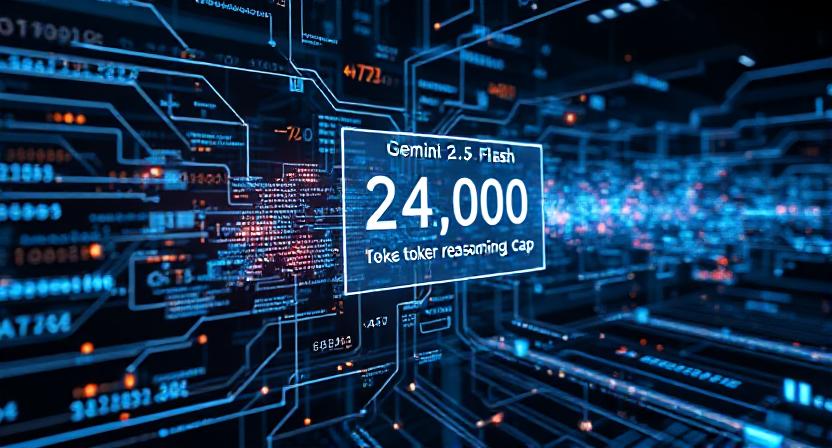Google Gemini 2.5 Flash Sets New Speed & Cost

Google Reinvents AI with Gemini 2.5 Flash and Hybrid Reasoning In 2025 Google DeepMind elevated its Gemini platform with the release of Gemini 2.5 Flash,A carefully...
⏱️ Estimated reading time: 4 min
Latest News
Google Reinvents AI with Gemini 2.5 Flash and Hybrid Reasoning
In 2025 Google DeepMind elevated its Gemini platform with the release of Gemini 2.5 Flash,A carefully engineered hybrid reasoning model that redefines the balance between speed cost efficiency and intelligence. As a result it serves as the workhorse of the Gemini 2.5 family. Notably Flash offers developers fine-grained control over how much the model thinks, making it ideal for both high throughput applications and more complex reasoning tasks.
1. The Launch Timeline
- March 2025: Google initially unveiled the Gemini 2.5 family, starting with the Pro Experimental version. It demonstrated state‑of the art reasoning performance and topped key benchmarks like GPQA and AIME without extra voting techniques blog.google.
- April 17–18, 2025: Google released Gemini 2.5 Flash in public preview. It became available through Google AI Studio Vertex AI the Gemini API and the consumer-facing Gemini app labeled 2.5 Flash Experimental.
- May 20, 2025 (Google I/O 2025): Google showcased updated versions of both Flash and Pro. Key upgrades included better reasoning, native audio output, multilingual and emotional dialogue support, and an experimental Deep Think mode for 2.5 Pro.
- June 2025: Gemini 2.5 Flash reached general availability. It was declared production-ready and accessible on AI Studio Vertex AI the Gemini API and the Gemini app.
- July 22, 2025: Google launched Gemini 2.5 Flash‑Lite. As the fastest and most cost efficient model yet it’s designed for latency-sensitive high-volume tasks marking the final release in the 2.5 series.
2. What Is Hybrid Reasoning?
At the core of Gemini 2.5 Flash is hybrid reasoning a feature allowing developers to toggle internal reasoning on or off and set a thinking budget to manage quality latency and cost.
- Thinking Mode ON: The model generates internal thought tokens before producing an answer mimicking deliberation to improve accuracy on complex tasks.
- Non‑Thinking Mode OFF: Delivers lightning fast responses akin to Gemini 2.0 Flash, but with improved baseline performance compared to its predecessor .
- Thinking Budgets: Developers can cap the number of tokens used in reasoning, allowing smart trade‑offs between computational cost and output accuracy .
Consequently this novel mechanism enables Flash to operate efficiently in high‑volume environments for example, summarization and classification while still scaling up reasoning when needed.
3. Hybrid Reasoning Improvements over Gemini 2.0
- Superior reasoning: Even with reasoning turned off Gemini 2.5 Flash still outperforms Gemini 2.0 Flash’s non thinking baseline across key benchmarks.
- Token efficiency: Processes tasks using 20-30% fewer tokens, improving both latency and cost efficiency .
- Longer context support: A 1‑million‑token context window enables handling massive inputs across text, audio, image and video modalities .
- Multimodal inputs: Natively supports multimodal reasoning text audio vision and even video matching the broader Gemini capabilities .
4. Practical Capabilities & Use Cases
- Flash‑Lite has emerged as the entry‑level variant, optimized for cost‑sensitive latency critical use cases with pricing at $0.10 per million input tokens and $0.40 per million output tokens. Early adopters report 30% reductions in latency and power consumption in real‑time satellite diagnostics Satlyt large scale translation HeyGen video processing and report generation DocsHound Evertune .
Flexibility for Developers
- Fine‑grained reasoning control enables developers to balance cost and performance precisely. For example this capability proves invaluable for environments such as chatbots, summarizers data extraction pipelines or translation systems that must switch between fast and thoughtful outputs.

Reasoning‑Heavy Workloads
- When configured in reasoning mode Gemini 2.5 Flash handles logic mathematics code interpretation and multi‑step reasoning with extra care and precision especially given the 24,000‑token reasoning cap developers can set a thinking budget up to 24,576 tokens
5. Technical Foundations
- A sparse mixture‑of‑experts architecture, which activates subsets of internal parameters per token delivering high capacity without proportional compute cost .
- Notably, advanced post training and fine tuning methods combined with multimodal architecture upgrades relative to earlier Gemini generations significantly enhance general reasoning long context capability and tool use performance.
6. Developer Experience & Ecosystem
- Platform Availability: Gemini 2.5 Flash is now generally available in Google AI Studio Vertex AI and the Gemini API meanwhile the Gemini app also supports it across platforms enabling a seamless transition from experimentation to production.
- Explainability tools: Flash now supports thought summaries developer visible overviews of the model’s internal reasoning process. Consequently this feature enhances debugging, explainability, and trust especially when used via the Gemini API or Vertex AI.
- Expanding tool chain integration: Support for open‑source model control protocols e.g. MCP tools enables deep integration with third‑party frameworks and custom tool use workflows .
7. How This Fits into the Gemini 2.5 Landscape
| Model | Reasoning Behavior | Strengths | Best Use Cases |
|---|---|---|---|
| Gemini 2.5 Pro | Full thinking & optional Deep Think | Highest reasoning multimodal code | Complex reasoning coding agents |
| Gemini 2.5 Flash | Hybrid reasoning (toggleable) | Speed + quality balance multimodal, scalable | Chat summarization mixed workloads |
| Gemini 2.5 Flash‑Lite | Minimal thinking (preview→GA) | Ultra-fast low-cost high throughput | High-volume tasks, translation extraction |
Related Posts

Adobe Acquires Semrush in $1.9B SEO Power Play
Adobe to Acquire Semrush for $1.9 Billion Adobe announced its agreement to acquire the search...
December 1, 2025

Warner Music & Udio Settle, Ink AI Music Deal
Warner Music and Udio Collaborate on AI Music Platform Warner Music Group (WMG) and AI...
November 21, 2025

Kaaj Secures $3.8M to Automate Credit Risk with AI
Kaaj Raises $3.8M Seed to Revolutionize Credit Risk Automation After a decade immersed in credit...
November 19, 2025











Leave a Reply